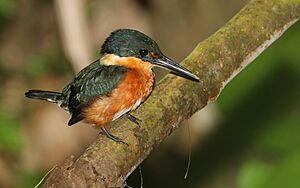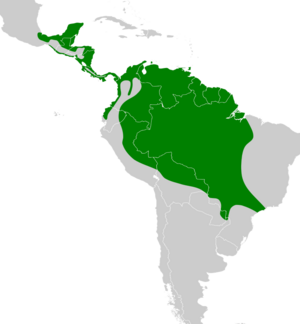American pygmy kingfisher facts for kids
Quick facts for kids American pygmy kingfisher |
|
|---|---|
 |
|
| Male | |
| Conservation status | |
| Scientific classification | |
| Genus: |
Chloroceryle
|
| Species: |
aenea
|
 |
|
| Synonyms | |
|
|
The American pygmy kingfisher (Chloroceryle aenea) is a tiny, colorful bird. It's known for its bright green feathers and its amazing diving skills. This little kingfisher lives near water in warm, tropical parts of the Americas. You can find it from southern Mexico all the way down through Central America and into most of South America. It also lives on the island of Trinidad.
Contents
About Its Name and Family
Scientists give every animal a special name. The first official description of the American pygmy kingfisher was made by a German scientist named Peter Simon Pallas in 1764. He called it Alcedo aenea. The word aenea comes from Latin and means "of a bronze color."
Later, in 1848, another scientist named Johann Jakob Kaup gave it the genus name Chloroceryle. This is the group it belongs to today.
Scientists also study how different animals are related. They found that the American pygmy kingfisher is closely related to the green-and-rufous kingfisher and the green kingfisher.
There are two main types, or subspecies, of the American pygmy kingfisher. They are called C. a. aenea and C. a. stictoptera.
What It Looks Like
The American pygmy kingfisher is about 13 centimeters (5 inches) long. That's pretty small! Males usually weigh between 10 and 16 grams. Females weigh a bit more, from 12 to 16 grams.
This bird has the classic kingfisher shape. It has a shaggy (messy-looking) crest of feathers on its head. It also has a long, strong beak that is black. The base of its lower beak is pale yellow. Its legs and feet are pinkish or light gray.
Males of the main type (C. a. aenea) have a shiny dark green head and back. They have a narrow reddish-brown collar around their neck. Their tail feathers are a bluer green. They have black patches near their eyes with a thin reddish-brown line. Their chin, throat, and most of their belly are reddish-brown. This color is darker on their chest. The very center of their chest and the feathers under their tail are white.
Adult females look similar to males. But they have an extra dark green band across their upper chest. Young birds have lighter colors on their belly. They also have buffy (light yellowish-brown) spots on their wings. Young males might have green-black streaks on their chest. The chest band on young females is often not complete.
The other type of kingfisher, C. a. stictoptera, has clear lines of white spots on its wing feathers. It also has some white on its rump (lower back). These two types mix in central Costa Rica.
Where It Lives and Its Home
The C. a. stictoptera subspecies lives further north. You can find it from southern Mexico through Belize, Guatemala, El Salvador, Honduras, and Nicaragua. It goes down to central Costa Rica.
The C. a. aenea subspecies lives from central Costa Rica (where it meets stictoptera) through Panama and into Colombia. From there, it lives west of the Andes mountains to central Ecuador. It also lives east and south into Venezuela, the Guianas, and most of the Amazon region in Colombia, Brazil, Peru, and Bolivia. Its home also stretches a little into Paraguay and Argentina, and includes Trinidad.
This kingfisher loves dense forests. It lives along small streams and rivers. You can also find it by pools of water, in swamps, and along tidal channels in mangrove forests. It avoids open areas. It can live from sea level up to about 2,600 meters (8,500 feet) high.
Behavior
Movement
The American pygmy kingfisher usually stays in the same area. It does not travel far.
Feeding
This kingfisher is a skilled hunter. It waits on a low branch or perch. When it sees prey in the water, it dives in headfirst! It eats small fish, like those from the Characidae and Cyprinodontidae families. It also eats tadpoles and frogs. Large insects, such as damselflies, are also on its menu. Some people have reported that it catches insects while flying, but this is not fully confirmed.
Breeding
The time when American pygmy kingfishers lay eggs changes depending on where they live. It can be as early as January in Mexico or as late as September in Trinidad.
Both the male and female work together to dig a nest. They make a burrow (a tunnel) in a river bank, a road cutting, or even in a termite nest in a tree. Sometimes they use the roots of a fallen tree. The tunnel is usually 30 to 40 centimeters (12 to 16 inches) long. At the end of the tunnel, there is a special chamber for the nest. They usually lay three or four eggs. Scientists don't yet know how long the eggs take to hatch or how long it takes for the young birds to leave the nest.
Vocalization
The American pygmy kingfisher makes a soft, repeated "tik" or "dzit, tsweek" sound. Sometimes, it makes these sounds faster, like a rattle or chatter. What scientists think is its song is "a series of musical chirps."
Status
The IUCN (International Union for Conservation of Nature) has looked at the American pygmy kingfisher. They have decided it is a species of "Least Concern." This means it is not currently in danger of disappearing. It lives in a very large area.
However, scientists estimate there are at least half a million adult birds. This number is thought to be going down. But there are no immediate big threats that have been found for this bird.



